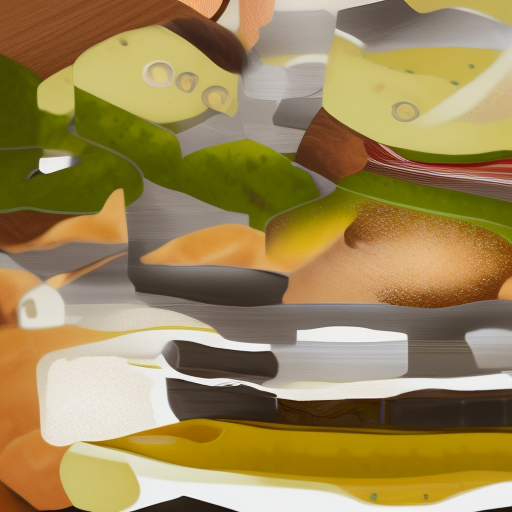Exploring Culinary Techniques: A Journey Through the Kitchen

1. Introduction to Culinary Techniques
Welcome to the world of culinary techniques! In this journey through the kitchen, we will explore the various methods of cooking that can take your meals from basic to gourmet. From boiling to sous vide, each technique will be explained in detail so that you can master them and become a pro in the kitchen. Let’s get started on our exploration of culinary techniques!

2. Boiling: The Basics
Boiling is one of the most basic cooking techniques, yet it can be incredibly versatile. It involves submerging food in water and heating it until the food is cooked through. Here are some tips for perfecting the art of boiling:
1. Use the right amount of water: Make sure you have enough water to fully immerse the food. Too little water and the food will not be completely submerged, which can cause uneven cooking. Too much water and the food will take longer to cook and may become overcooked.
2. Add the right amount of salt: Salt helps to enhance the flavor of the food and also helps to season it. Start with a small amount and add more as needed.
3. Stir occasionally: Stirring the pot occasionally helps to prevent sticking and ensures that the food is evenly cooked.
4. Don’t overcrowd the pot: If you try to boil too many items at once, they may not cook evenly or may take longer to cook.
5. Be patient: Boiling takes time, so be patient and don’t rush the process. Once the water has come to a boil, reduce the heat to maintain a gentle simmer.
With these tips, you’ll be well on your way to mastering the basics of boiling. Whether you’re cooking up a pot of pasta or a batch of vegetables, boiling is a fundamental technique that will serve you well in the kitchen.

3. Sauteing: Cooking with Flavor
Sauteing is a cooking technique that involves browning food in a pan using heat. It is a quick and easy way to add flavor and texture to dishes, making it a popular method among home cooks. To saute effectively, it is important to use the right tools and techniques. Start by heating a small amount of oil in a pan over medium-high heat. Then, add your ingredients and stir frequently until they are cooked through and have taken on the desired color and flavor. Be sure to use the right type of oil for the ingredients you are cooking, as some oils can impart undesirable flavors. For example, olive oil is a good choice for delicate vegetables and herbs, while avocado oil is great for high-heat cooking. Experiment with different types of oil and see what works best for you. Additionally, be mindful of the temperature and how long you cook your ingredients, as this can greatly affect the final result. With practice and experimentation, you’ll be able to master the art of sauteing and create delicious meals that are sure to impress.

4. Roasting: Perfecting Meats and Vegetables
Roasting is a cooking technique that involves baking food in an oven at a high temperature. It is a versatile method that can be used to cook meats and vegetables, resulting in tender, juicy dishes with a delicious caramelized crust. In this section, we will explore the basics of roasting, including how to choose the right cuts of meat and vegetables, as well as tips for achieving perfect results every time. Whether you’re a seasoned chef or a beginner in the kitchen, this guide will help you master the art of roasting and take your culinary skills to the next level.

5. Grilling: The Art of Cooking Outdoors
Grilling is a popular cooking method that involves cooking food over an open flame or heat source. It can be done outdoors in a grill or indoors on a griddle. Grilling adds a smoky flavor to food and is often used for meats such as steak, chicken, and fish. To grill food, you will need a grill or griddle, a heat source, and the food you want to cook. Start by preheating the grill or griddle to the desired temperature, then place the food on the grill or griddle and cook until it reaches the desired level of doneness. Grilling can be a great way to add flavor to your favorite dishes and is a fun and interactive way to cook.

6. Poaching: Delicate Dishes Made Easy
Poaching is a delicate cooking technique that is often overlooked in favor of more flashy methods like sautéing or grilling. However, poaching can be a powerful tool for creating tender and flavorful dishes that are perfect for special occasions or everyday meals.
In this section, we’ll explore the basics of poaching and how it can be used to create a variety of delicious dishes. We’ll start by discussing the equipment needed for poaching, including pots and pans with lids, as well as the different types of liquids that can be used for poaching.
Next, we’ll dive into the specifics of how to properly poach various types of foods, such as eggs, fish, and vegetables. We’ll cover the importance of maintaining a consistent temperature and the best ways to avoid overcooking or undercooking.
Finally, we’ll showcase some of our favorite poached dishes, from classic poached salmon to creative takes on the technique using ingredients like fruit and spices. By the end of this section, you’ll have a solid understanding of how to use poaching to create delicate and flavorful dishes that are sure to impress.

7. Sous Vide: The Future of Cooking
Sous vide cooking is a method in which food is vacuum sealed and cooked at a precise temperature in a water bath. This technique allows for evenly cooked dishes with a tender texture and a juicy flavor. It has become increasingly popular in recent years due to its ability to produce restaurant-quality meals at home. In this section, we will explore the basics of sous vide cooking and how it can enhance your culinary skills.

8. Smoking: Adding Flavor to Food
Smoking is a culinary technique that adds depth and flavor to food. It is a slow cooking method that uses smoke to cook the food, rather than heat. This method is often used to cook meats, such as ribs, brisket, and salmon, but can also be used on vegetables and even cheese. To smoke food, you will need a smoker or a specialized grill with a built-in smoker function. When using a smoker, it is important to monitor the temperature and smoke level to ensure that the food is cooked properly. Additionally, it is important to use the right type of wood chips to add the desired flavor to the food. Smoking can take time, patience, and practice to master, but the results are worth it.

9. Blanching: Quick and Efficient Cooking
Blanching is a culinary technique that involves submerging food in boiling water for a brief period of time. This method is commonly used to cook vegetables, fruits, and even some types of grains. The goal of blanching is to soften the texture of the food while preserving its nutrients and flavor. Here are some tips for perfecting the art of blanching:
1. Choose the right ingredients: Not all vegetables and fruits are suitable for blanching. It’s important to select items that can withstand being submerged in boiling water without becoming discolored or damaged. Common blanching candidates include broccoli, cauliflower, carrots, potatoes, and green beans.
2. Pre-cut the ingredients: To ensure even cooking, it’s best to pre-cut the vegetables into similar sizes before blanching. This ensures that they will cook at the same rate, resulting in consistent texture and taste.
3. Use the correct amount of water: When blanching, it’s essential to use enough water to fully submerge the food. However, too much water can cause the food to become overcooked and mushy. Start with a small batch of water and adjust as needed based on the volume of food being blanched.
4. Monitor the cooking time: Blanching times vary depending on the type of food being cooked. As a general rule, vegetables take less time to blanch than fruits. Keep a close eye on the food during the blanching process to prevent overcooking or undercooking.
5. Drain and cool the food promptly: Once the blanching process is complete, quickly remove the food from the hot water and transfer it to an ice bath or cold water to stop the cooking process. Allow the food to cool completely before draining and serving.
By following these simple steps, anyone can master the art of blanching and enjoy quick and efficient cooking results.

10. Conclusion: Mastering Culinary Techniques
Once you have mastered these culinary techniques, you will be able to take your cooking to the next level. Whether you are a seasoned chef or a beginner, there is always something new to learn and explore in the kitchen. With a little practice and patience, you can become a master of flavor and technique. So don’t be afraid to get creative and experiment with different ingredients and cooking methods. The journey of mastering culinary techniques is one that is full of excitement, discovery, and delicious rewards.

